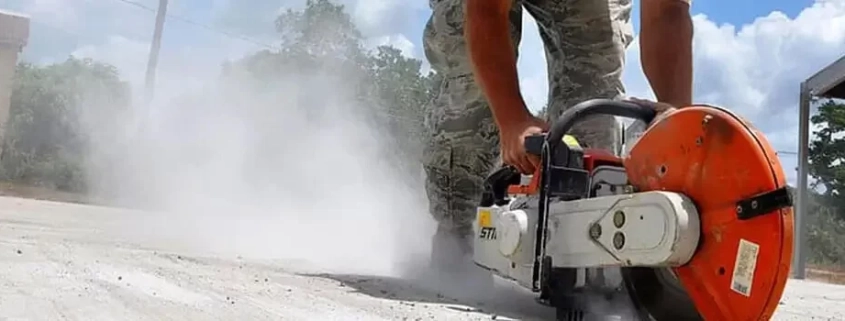Crystalline Silica – Hazards and Respiratory Protection
Crystalline silica is ubiquitous in various fields of activity, such as construction, quarries, glass works or even foundries. alveolar powder In its form, it poses a real danger to the health of workers when inhaled. Our experts tell you this harmful dust features and to be used will demonstrate respiratory protection equipment.
Dangers of silica
What is crystalline silica?
Silica is an element found in many minerals in different forms, especially in crystalline or amorphous form. Its pure form crystallizes under different temperature and pressure conditions. Among them: quartz , tridymite And cristobalite is found .
Crystalline silica is a common element in the earth's crust. Indeed, sand, granite, concrete, stone, etc. It is also found in many mineral-based construction materials such as. less than 5 micrometers Respirable alveolar powder of crystalline silica (defined by its ability to reach the lung alveoli), having a size smaller than (microns), produced by many professional activities . A real thing when inhaled health hazard creates .
Health effects
Crystalline silica, known It is classified as a human carcinogen (group 1) . Exposure to and inhalation of such dust A lot It may cause health problems:
- skin irritations
- eye inflammation
- bronchitis
- emphysema
- tuberculosis
- immune system damage
- autoimmune diseases
- lung cancer
- silicosis
The fact that this potentially lethal substance is dangerous to the body means that safety precautions must be taken for all exposed persons.
exposure situations
Exposure to crystalline silica dust It is a ubiquitous risk in many areas of activity, especially on construction sites and certain workshops. In France alone, ANSES (French National Agency for Food, Environmental and Occupational Health Safety) estimates that approximately 365,000 workers are affected by exposure to this element in their occupational activities.
Occupational fields affected by crystalline silica risk:
- Construction / Building works
- stone cutting
- Cement production and use
- Ceramics and porcelain production
- glass works
- Dental prosthesis production
- Foundry
- Plastic production
- Mines and quarries
Silica: regulation and prevention
Regulations
Hazards caused by the presence of crystalline silica in many occupational activities strict regulations It leads to . In France and Europe, exposure to this substance is limited by law to certain levels.
| Occupational exposure limit value over 8 hours | |
| Crystalline silica : | OEL mg/m3 |
| alveolar quartz dust | 0.1mg/m3 |
| alveolar cristobalite dust | 0.05mg/m3 |
| alveolar tridymite dust | 0.05mg/m3 |
Additionally, since 1997 crystalline silica has been classified as a carcinogen by IARC (WHO International Agency for Research on Cancer). This classification, and its recognition by various national authorities, allows employers to identify certain CMR agents (carcinogenic, mutagenic or toxic to reproduction) requires regulatory obligations.
Preventing the danger of silica
Dangers of crystalline silica and in the face of applicable regulations, prevention plays an important role in various applications exposed to such respirable dust. This dust in working environments Many arrangements can be made to minimize its formation. Among these collective protection and security measures we note:
- wet job
- workstations isolation
- Use of dust extraction cabinets
- mechanization of hazardous work
- risk assessment
- working atmosphere control
- enhanced monitoring of exposed workers
- thorough cleaning of exposed areas
- Use of PPE (personal protective equipment)
- Proper care of PPE used
Finally, in addition to these preventive measures, such as asbestos respiratory protection, concerned persons (employees, workers) need to be systematically informed about the risks posed by the presence of crystalline silica.
Silica protective equipment
Crystalline silica exposure prevention methods should be accompanied by personal protective equipment. respiratory protection mask use and dust jacket Wearing it ensures that exposure to danger is minimized.
Silica respiratory protection mask
In addition to various precautionary measures, to ensure the safety of workers exposed to crystalline silica into fine particles It is also important to wear a specially adapted respiratory protection mask.
GVS Elipse mask
Nowadays ultrafine particles There are very few dust masks that can filter . In fact, most gas mask filter manufacturers offer equipment that filters particles in the 1 to 0.6 micron range. Breathable crystalline silica powder with a diameter of less than 5 microns Since particles up to 0.3 µm are regularly present, these are not filtered out by protective devices. Exposure to such particles requires the use of very high-performance filters.
For this purpose, our experts recommend the use of the GVS Elipse mask with P3 filter.
This respiratory protection mask is ergonomic, easy to use, very comfortable to wear and high precision filters has . GVS mask technology, HESPA® (High Efficiency Synthetic Particulate Air Filter) multilayer pleated filter uses . These P3 filters have a minimum efficiency of 99.95% or greater for 0.3 micron particles. They have a Nominal Protection Factor (PNF) of 40 (reducing dust concentration between the outside and inside of the mask by 40%). These filters are effective up to a maximum of 50 times the OEL. All these features make this mask ideal for protection against alveolar crystalline silica dust.
Powered air-purifying respirators for long-term operation
For operators working in contact with silica for extended periods of time, we recommend using powered air-purifying respirators, which are the most effective way to filter respiratory protection.
CleanSpace Pro, ALL IN ONE It is an electric air purifying respirator. . Without cables and with a motor block located at the base of the neck, the user is protected against fine particles and enjoys complete freedom of movement. It is completely suitable for the construction industry or quarries where workers are in contact with silica dust for long hours. It is innovative, adjusts the airflow according to the user's breathing and has 14 hours of autonomy.
The PureFlo 3000 powered air purifying helmet has an integrated motor and filter inside. It covers the entire respiratory tract, head and face. It is wireless, offering the user ease of use regardless of operating time. HEPA filter Equipped with PureFlo 3000, it effectively protects against aerosols and small particles such as lead or crystalline silica. Therefore it is suitable for the construction, cement and sandblasting industries.
Dust protective suit
To maximize protection against crystalline silica particles dust dress It is also recommended to wear This type of PPE, protective suit or HAZMAT suit, provides a barrier against respirable dust exposure. This is reusable or disposable protection , particle contamination and should be used to prevent them from being carried outside the workplace.
Our expert team recommends wearing an NS Series coverall when silica dust is present. This type 5 and 6 are disposable personal protective equipment, Provides category 3 protection against liquid splashes and dust. Ergonomically designed, this product offers comfort and prevents substances from entering thanks to retractable arms, 2-piece diamond tights and elastic tightening. Suitable for cement and mining industries.
Another form of protective clothing is equally effective in combating fine dust particles and is suitable for workers who come into contact with crystalline silica. The TS series microporous combination features an adhesive tape seal to prevent dust penetration. It is made of polyethylene and fits tightly to the body, offering comfort and ease of movement when working with silica. Stonemasons and construction workers may find it perfect for their applications.
GTC Industrial is at your service for the selection of your chemical clothing and respiratory protection equipment. Feel free to contact us for information or to request a quote.


